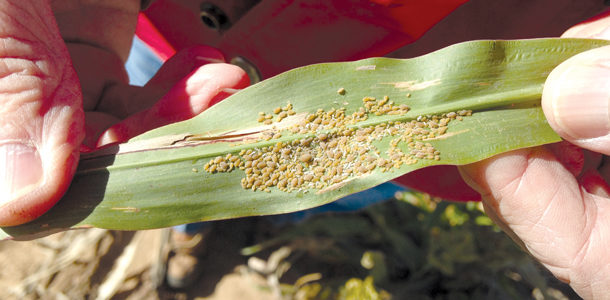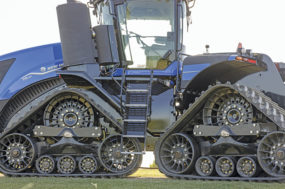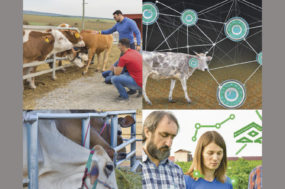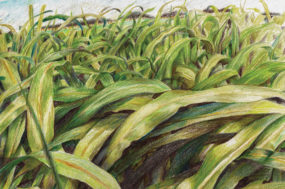Aphid numbers can increase very rapidly, killing leaves, stunting growth and reducing grain and forage yields. Insecticides are effective, but fields must be frequently scouted to detect infestations early and apply an insecticide before crop injury occurs.
The sugarcane aphid originally fed only on sugarcane in the U.S. This insect was first found feeding on sorghum in 2013 in Texas and Louisiana.
This new sorghum-feeding biotype resulted from either a genetic change in the existing U.S. aphid population or a new pest introduction into the U.S. Sugarcane aphids feed on grain and forage sorghum (sudangrass, haygrazer, etc.), johnsongrass (all of these hosts are in the genus Sorghum) and sugarcane.
Identification
Sugarcane aphids are pale yellow, gray or tan in color and are usually found in colonies on the underside of leaves. They have black cornicles (the tail pipe-like structures on the rear end) and black antennae.
Sugarcane aphids feed by piercing the leaf and sucking plant sap. Infested leaves turn yellow and brown as they die. Infestations can result in poor head emergence and reduced yield and quality.
Sugarcane aphids produce large quantities of a sticky waste material called honeydew, which accumulates as a shiny, sticky layer on leaves and stems. A sooty mold can grow on the honeydew, causing the leaves and stems to turn black.
The honeydew-contaminated leaves and stems can also gum up combines at harvest. Honeydew is composed primarily of plant sugars and water and eventually dries to a harmless residue. The greenbug is another aphid pest of sorghum that feeds on the underside of sorghum leaves. The greenbug is light green with a dark green strip down its back.
Detecting infestations
Sugarcane aphids are all females and give birth to live young. As a result, populations can increase very rapidly. For this reason, sorghum fields should be scouted once a week, and once sugarcane aphids are present in the field, twice-a-week scouting is recommended.
While walking down the row, examine the underside of leaves for sugarcane aphids and look for honeydew, which can indicate the presence of a sugarcane aphid on the leaf above.
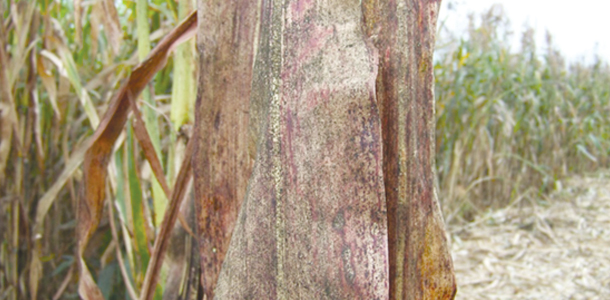 Infestations and leaf damage often start low on the plant and move up. Look for sugarcane aphids in several areas of the field, both along field margins and the interior, and sites where johnsongrass is present.
Infestations and leaf damage often start low on the plant and move up. Look for sugarcane aphids in several areas of the field, both along field margins and the interior, and sites where johnsongrass is present.
Treatment thresholds
Treatment or action thresholds are designed to control aphid populations before they increase to high numbers more difficult to control and before infestations have resulted in significant plant damage or accumulation of honeydew. In Texas, a proposed treatment threshold prior to heading in grain sorghum is when sugarcane aphids average 50 to 125 per leaf.
Check with your cooperative extension service for thresholds developed in other states. As this is a new pest of forage sorghum, there is yet no research basis for determining how sugarcane aphids reduce yield or quality of forage sorghums.
However, observations of infested fields show rapid death of leaves when sugarcane aphids are abundant, suggesting a significant impact on quality and production. Until treatment thresholds are developed for forage sorghums, the thresholds for grain sorghum can be used.
Control with insecticides
Insecticides such as chlorpyrifos and dimethoate, used to control other aphid pests in sorghum, are generally ineffective for control of sugarcane aphids.
The insecticide Transform WG (Dow AgroSciences) is labeled under a Section 18 Emergency Exemption for control of sugarcane in sorghum in 2015 in Texas, Louisiana, Mississippi, Arkansas, Alabama and Georgia.
Contact your cooperative extension service or Dow AgriSciences to determine if the Section 18 label for Transform has been approved for other states.
The insecticide Sivanto 200SL (Bayer CropScience) has been issued a Section 2(ee) label for use on sorghum to control sugarcane aphid in 2015 in Alabama, Arkansas, Florida, Georgia, Kansas, Louisiana, Mississippi, Missouri, North Carolina, Oklahoma, South Carolina, Tennessee and Texas.
Both insecticides can be applied to grain and forage sorghums. Good coverage is necessary for effective control. Read and follow label directions regarding days after application to harvest or grazing and other restrictions.
Forage sorghums
Control of sugarcane aphid with insecticides requires good coverage of the entire canopy, including lower leaves, which is very difficult to achieve in forage sorghum due to the dense canopy and especially if the crop is tall.
If good insecticide coverage cannot be achieved, early harvest of infested fields may be an option in limiting further crop loss by sugarcane aphids. Infestations should be confirmed by the presence of colonies of sugarcane aphids on the underside of leaves, leaf discoloration and honeydew accumulations on leaves.
Once the field is harvested, the sugarcane aphids will likely persist on the remaining leaves and again infest the regrowth. If a second cutting is planned, monitor the aphid population and plant damage on the regrowth to determine if an insecticide treatment is needed following first harvest.
Good canopy coverage by the insecticide should be achieved at this time due to the short stature of the crop. Continue to monitor sugarcane aphid populations and plant damage after treatment.
What to expect in 2015
Sugarcane aphids need living sorghum or johnsongrass plants to persist, and infestations die out where winter cold kills these host plants.
Johnsongrass and sorghum can survive the winter in the Rio Grande Valley and lower Gulf Coast of Texas, and sugarcane aphids can be found here during the winter. Some sugarcane aphids are winged, and although weak fliers, they can be carried by the wind.
It is believed that sugarcane aphids were carried by wind from these overwintering sites in south Texas into more northern regions in 2014. It is expected that, beginning this spring, this pest will again be carried by the wind from overwintering sites and eventually disperse throughout the Southeast as it did last year.
This new pest can be managed, but frequent field inspections (one to two times per week) and timely application of an insecticide according to treatment thresholds, or early harvest as in the case of forage sorghums, may be necessary to avoid crop loss.
The future
Recent lab studies have shown that some sorghum hybrids have some genetic resistance to sugarcane aphids. These hybrids exhibited less damage or aphid populations developed more slowly than other hybrids.
Visit with your seed dealer about hybrids that may be less sensitive to sugarcane aphids. Also, breeding lines of sorghum with genetic resistance to sugarcane aphids have been identified, and new hybrids with good levels of resistance to sugarcane aphids are under development. FG
PHOTOS
PHOTO 1: Several hundred sugarcane aphids form a large colony on the underside of a sorghum leaf. The sugarcane aphid originally fed only on sugarcane in the U.S. This insect was first found feeding on sorghum in 2013 in Texas and Louisiana.
PHOTO 2: Black, sooty mold collects on forage sorghum leaves invaded by sugarcane aphids. Dead and dying leaves are the result of feeding by sugarcane aphids. Photo courtesy Mike Berry, Texas A&M AgriLife Extension.
Allen Knutson
Professor and Extension Entomologist
Texas A&M AgriLife Extension
